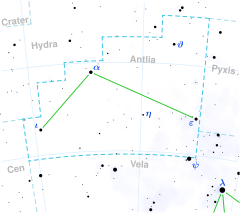Theta Antliae
| Observation data Epoch J2000 Equinox J2000 | |
|---|---|
| Constellation | Antlia |
| Right ascension | 09h 44m 12.09512s[1] |
| Declination | –27° 46′ 10.1011″[1] |
| Apparent magnitude (V) | 4.79[2] |
| Characteristics | |
| Spectral type | A8 Vm + G7 III[3] |
| U−B color index | +0.35[2] |
| B−V color index | +0.50[2] |
| Astrometry | |
| Radial velocity (Rv) | +24.0[4] km/s |
| Proper motion (μ) | RA: –53.23[1] mas/yr Dec.: +37.24[1] mas/yr |
| Parallax (π) | 7.5602 ± 0.8169 mas[5] |
| Distance | approx. 430 ly (approx. 130 pc) |
| Orbit[6] | |
| Companion | θ Ant B |
| Period (P) | 18.32 yr |
| Semi-major axis (a) | 0.134″ |
| Eccentricity (e) | 0.445 |
| Inclination (i) | 124° |
| Longitude of the node (Ω) | 176.8° |
| Periastron epoch (T) | 1965.75 |
| Details[7] | |
| θ Ant A | |
| Mass | 1.8 ± 0.1 M☉ |
| θ Ant B | |
| Mass | 2.1 ± 0.5 M☉ |
| Other designations | |
| Database references | |
| SIMBAD | data |
Theta Antliae (θ Ant, θ Antliae) is the Bayer designation for a binary star in the southern constellation of Antlia. The pair have a combined apparent visual magnitude of +4.78;[2] the brighter component is magnitude +5.30 while the secondary is +6.18.[9] Based upon parallax measurements, it is located at a distance of around 430 light-years (130 parsecs) from Earth.
The primary component of this system, θ Antliae A, has a stellar classification of A8 Vm,[3] indicating that it is an A-type main sequence star with enhanced metallic lines in its spectrum. The companion, θ Antliae B, is a giant star with a classification of G7 III.[3] The pair have an orbital period of 18.3 years, a significant eccentricity of 0.445, and they have an angular separation of 0.1 arcseconds.[6]
References
- ^ a b c d van Leeuwen, F. (November 2007), "Validation of the new Hipparcos reduction", Astronomy and Astrophysics, 474 (2): 653–664, arXiv:0708.1752, Bibcode:2007A&A...474..653V, doi:10.1051/0004-6361:20078357.
- ^ a b c d Johnson, H. L.; et al. (1966), "UBVRIJKL photometry of the bright stars", Communications of the Lunar and Planetary Laboratory, 4 (99): 99, Bibcode:1966CoLPL...4...99J.
- ^ a b c Ginestet, N.; Carquillat, J. M. (December 2002), "Spectral Classification of the Hot Components of a Large Sample of Stars with Composite Spectra, and Implication for the Absolute Magnitudes of the Cool Supergiant Components", The Astrophysical Journal Supplement Series, 143 (2): 513–537, Bibcode:2002ApJS..143..513G, doi:10.1086/342942.
- ^ Wilson, Ralph Elmer (1953), "General catalogue of stellar radial velocities", Washington, Carnegie Institution of Washington, Bibcode:1953GCRV..C......0W.
- ^ Brown, A. G. A.; et al. (Gaia collaboration) (August 2018). "Gaia Data Release 2: Summary of the contents and survey properties". Astronomy & Astrophysics. 616. A1. arXiv:1804.09365. Bibcode:2018A&A...616A...1G. doi:10.1051/0004-6361/201833051. Gaia DR2 record for this source at VizieR.
- ^ a b Heintz, W. D. (March 1982), "Orbits of 16 visual binaries", Astronomy and Astrophysics Supplement Series, 47: 569–573, Bibcode:1982A&AS...47..569H.
- ^ Docobo, J. A.; Andrade, M. (2012). "Dynamical and physical properties of 22 binaries discovered by W. S. Finsen". Monthly Notices of the Royal Astronomical Society. 428: 321. Bibcode:2013MNRAS.428..321D. doi:10.1093/mnras/sts045.
{{cite journal}}: CS1 maint: unflagged free DOI (link) - ^ "tet Ant". SIMBAD. Centre de données astronomiques de Strasbourg. Retrieved 2012-06-28.
{{cite web}}: CS1 maint: postscript (link) - ^ Eggleton, P. P.; Tokovinin, A. A. (September 2008), "A catalogue of multiplicity among bright stellar systems", Monthly Notices of the Royal Astronomical Society, 389 (2): 869–879, arXiv:0806.2878, Bibcode:2008MNRAS.389..869E, doi:10.1111/j.1365-2966.2008.13596.x.
{{citation}}: CS1 maint: unflagged free DOI (link)

